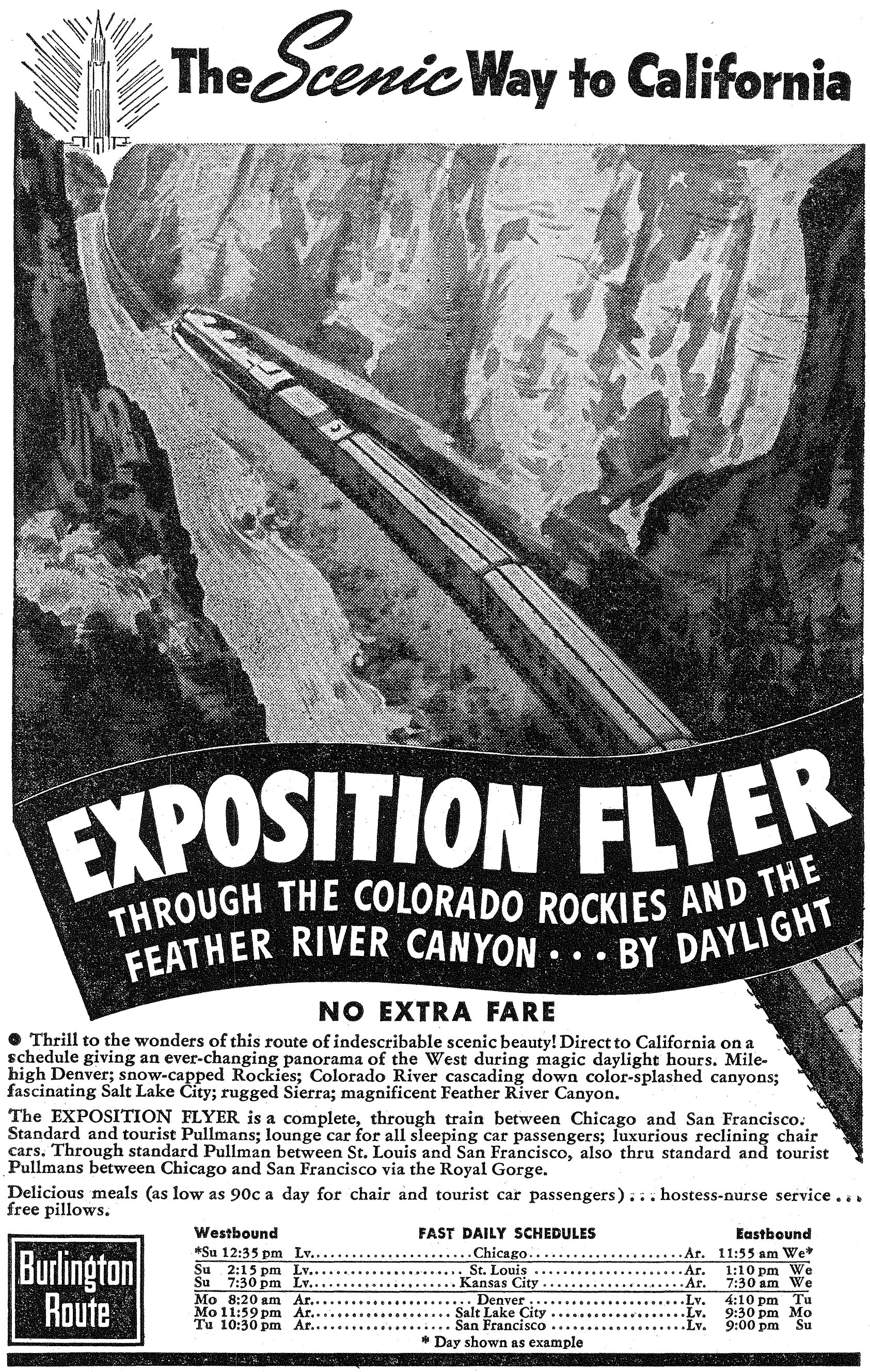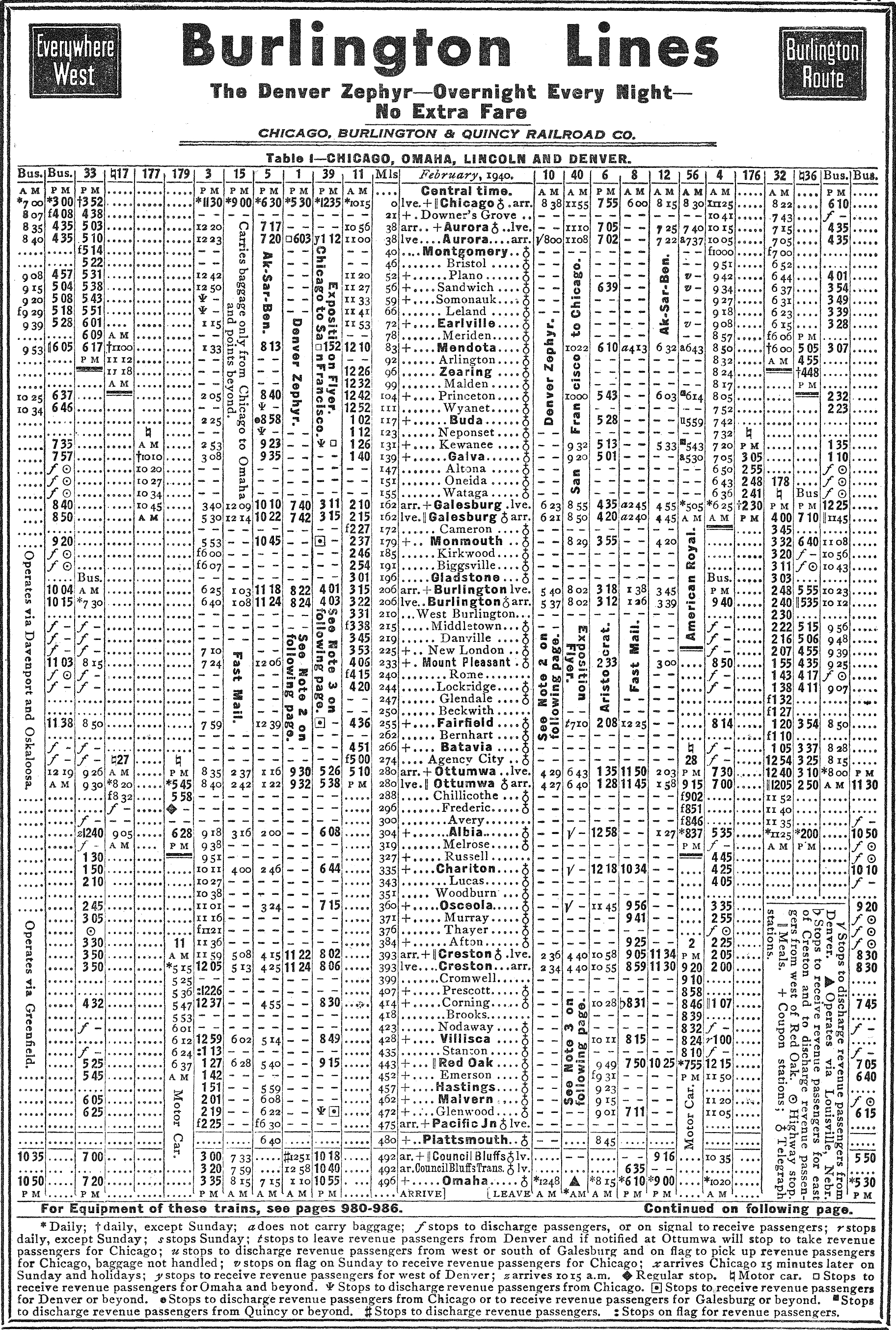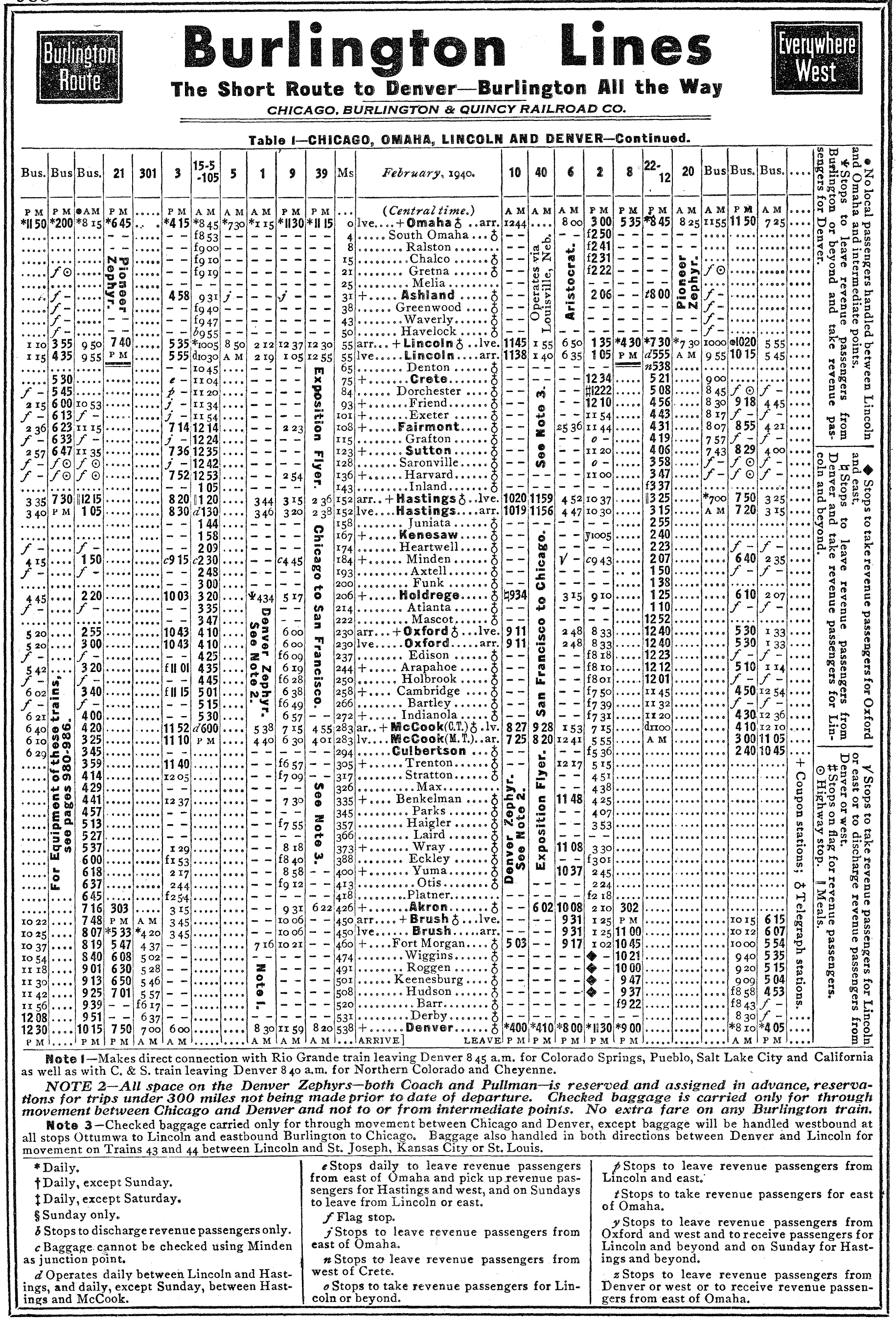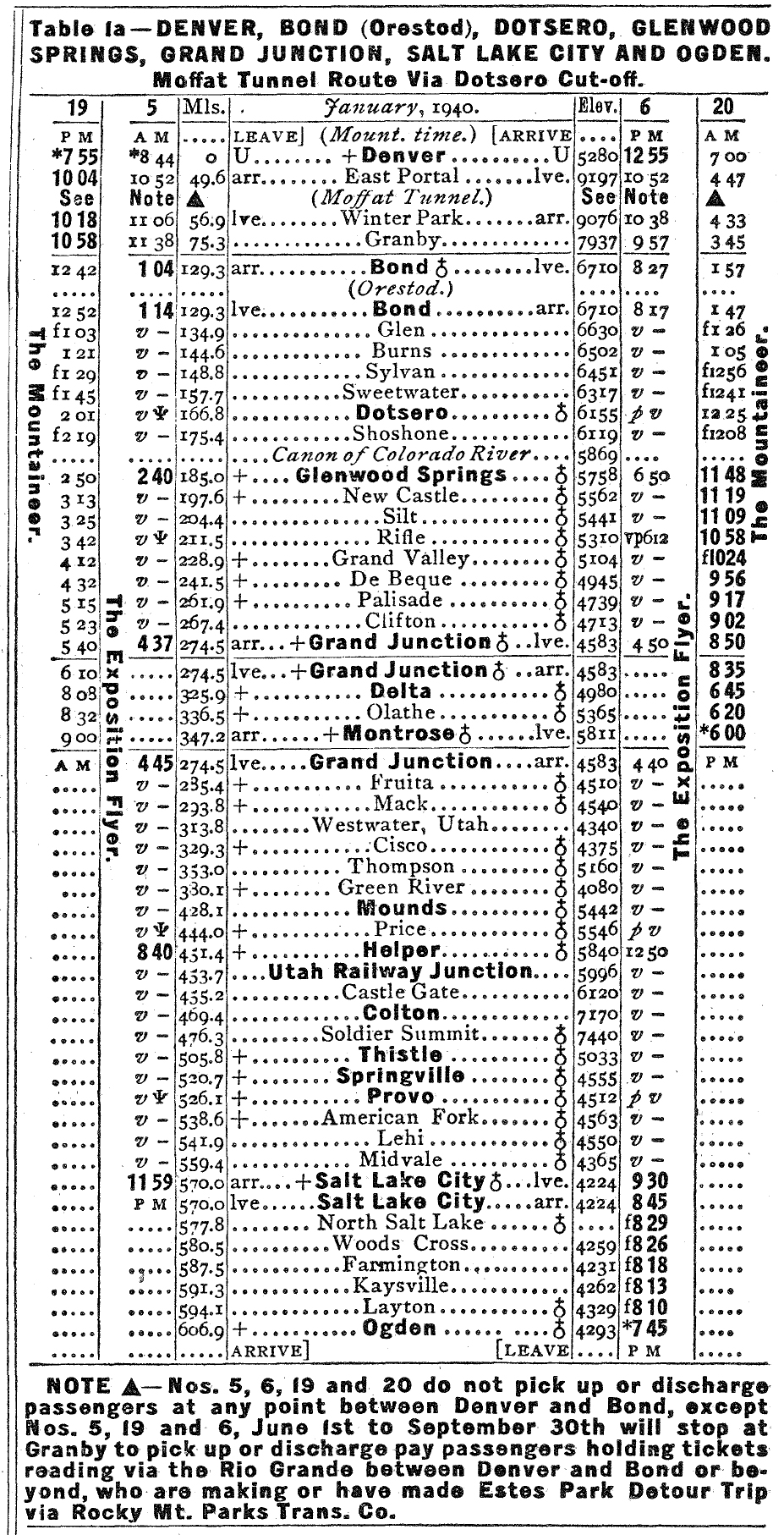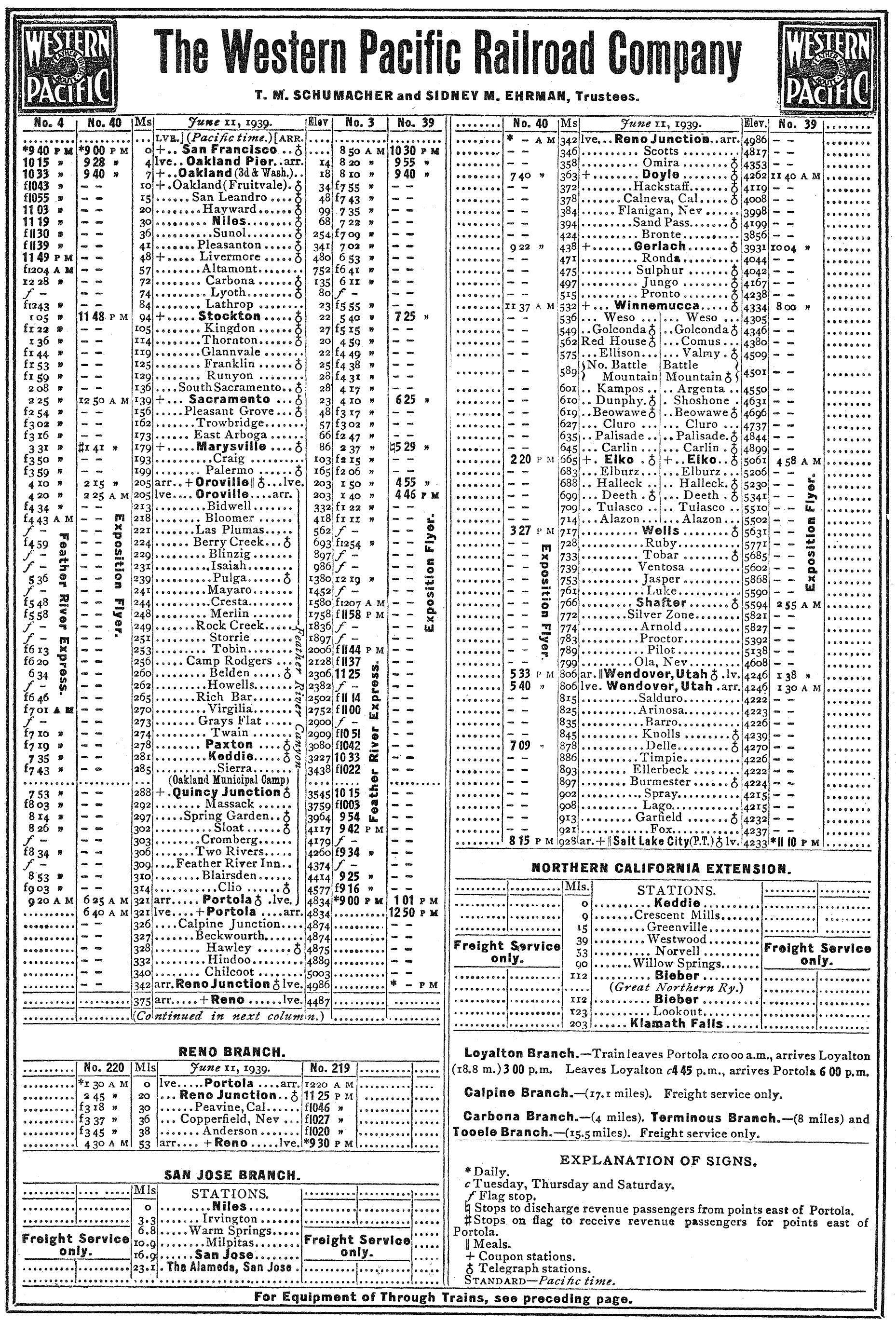"Exposition Flyer" (Train): Consist, Timetable, History
Last revised: August 25, 2024
By: Adam Burns
The Exposition Flyer was a non-streamlined passenger train operated by the Burlington, Western Pacific, and Rio Grande between Chicago and Oakland, California.
It was launched in 1939 to commemorate the Golden Gate International Exposition, a World's Fair held in San Francisco. The train was known for its speed and luxury, offering amenities such as air conditioning, a dining car, lounge, and standard Pullman sleepers.
Interestingly, the train was never intended to remain as a long-running service. In their book, "Streamliners: History Of A Railroad Icon," authors Mike Schafer and Joe Welsh note the heavyweight, steam-powered consist ran a schedule 20 hours slower than Union Pacific's newly streamlined City of San Francisco.
Nevertheless, the incredibly scenic route allowed the Exposition Flyer to maintain strong patronage. It continued to operate for a decade before the three railroads launched a new streamliner, the California Zephyr, one of the most successful of its era.
Photos
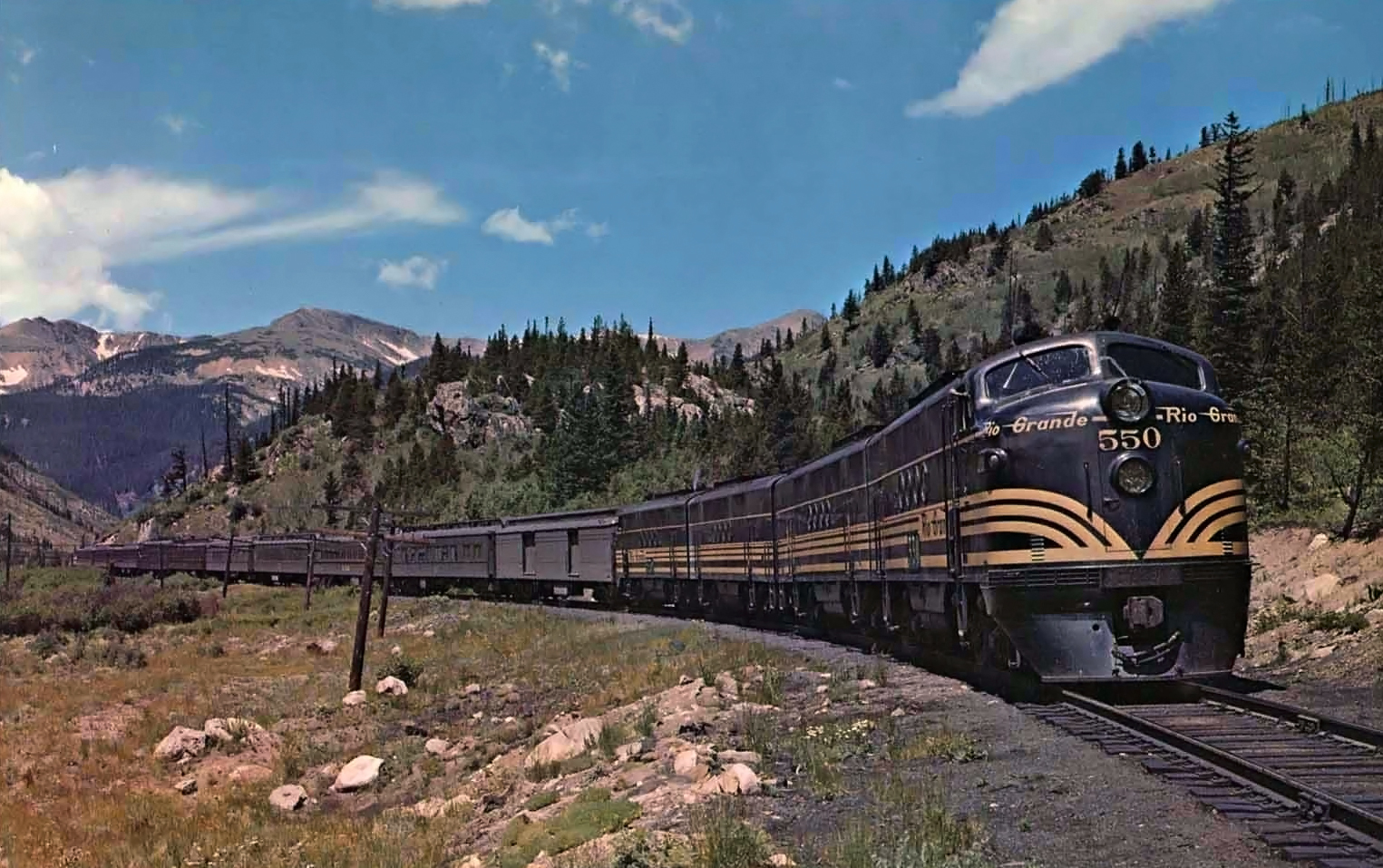 A rare color photo of the post-World War II transcontinental "Exposition Flyer," precursor of the "California Zephyr," 1.5 miles east of Moffat Tunnel led by an A-B-B-A set of FT's.
A rare color photo of the post-World War II transcontinental "Exposition Flyer," precursor of the "California Zephyr," 1.5 miles east of Moffat Tunnel led by an A-B-B-A set of FT's.Inauguration
The Exposition Flyer was inaugurated on June 10, 1939. It was a joint operation of three distinguished railroads – the Chicago, Burlington, and Quincy; Denver and Rio Grande Western; and Western Pacific .
The train was renowned for its remarkable route. It traced a picturesque trail from Chicago to Oakland, spanning a remarkable variety of landscapes across the central and western United States.
Golden Gate International Exposition
The historical backdrop of the Exposition Flyer's inauguration ties in with the Golden Gate International Exposition happening in 1939. This event, held on San Francisco's Treasure Island, was a World's Fair celebrating the completion of the San Francisco-Oakland Bay Bridge and the Golden Gate Bridge.
The Exposition Flyer was more than a means of transportation; it exemplified the elegance and luxury of travel during its time. A variety of services were offered onboard, including secure Pullman sleeping cars, a delectable dining car service, and later, dome cars for panoramic viewing of the outstanding landscapes.
While the train's introduction was timed with the Golden Gate International Exposition, its popularity urged its continuance, making it a permanent fixture on the tracks well beyond the exposition period. It was indeed a testament to its popularity that it continued to serve passengers for almost a decade.
The exact distance covered by the Flyer was an impressive 2,532 miles. This extensive route made it one of the most adventurous and intriguing rail travels of its time, offering a cross-sectional view of America's heartland and West.
On the eastern end, the train originated in Chicago’s magnificent Union Station. On the western terminus, it found its way to Western Pacific's 3rd Street Station in Oakland, thereby bridging two worlds and making transcontinental travel more accessible and enjoyable.
In addition, the train made notable stops at Denver Union Station, Burlington's Omaha Station (located at 1001 South 10th Street), and the Rio Grande Depot in Salt Lake City (located at 300 Rio Grande Street).
Consist (1940)
Burlington
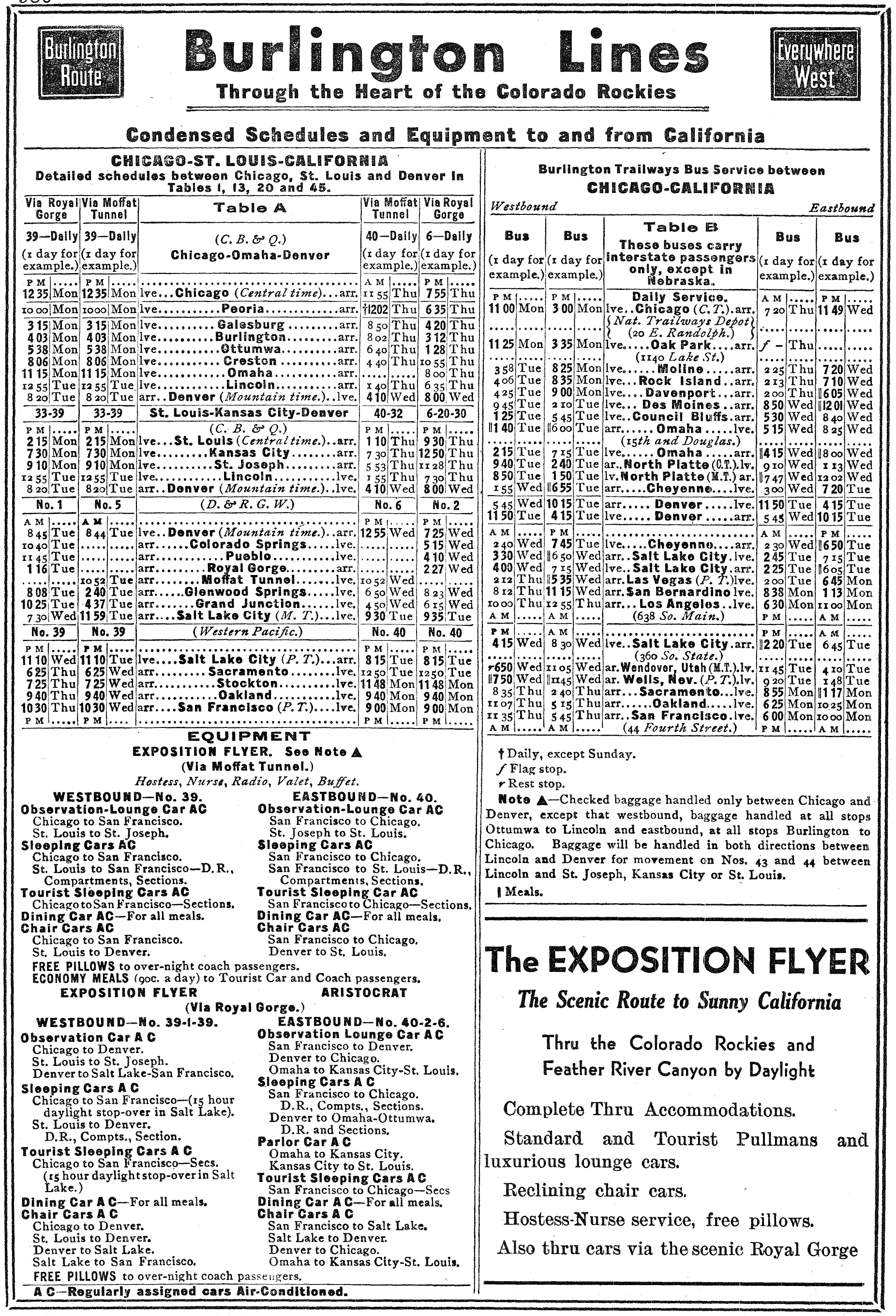
Rio Grande
Western Pacific
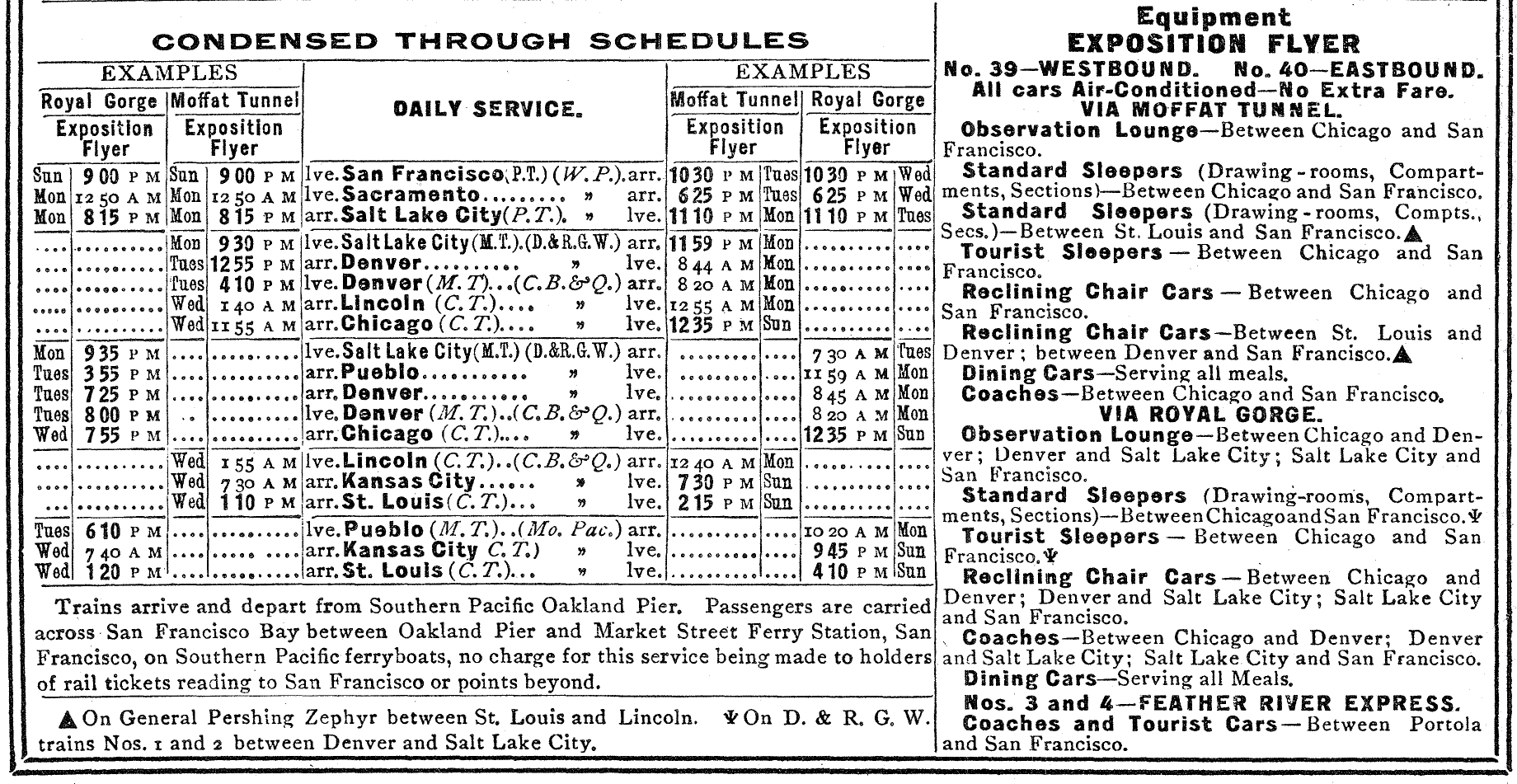
The technological evolution of the Exposition Flyer over its operational span was evident through the changes in its locomotives. Initially, the service utilized steam locomotives and heavyweight passenger cars.
However, as technology advanced, the train's rolling stock evolved to lightweight streamlined cars and diesel locomotives, a sign of things to come with the anticipation of the California Zephyr's launch.
In his book, "Burlington Route: A History Of The Burlington Lines," author Richard Overton notes the Burlington was the first railroad to handle through sleepers from coast-to-coast when the Exposition Flyer left San Francisco/Oakland on March 31, 1946 with a sleeper bound for New York.
In addition, the train handled the first through sleeper from the east coast when the Flyer departed Chicago Union Station a few days later on April 4th.
California Zephyr
Ultimately, the Exposition Flyer made its final journey on March 19, 1949. Its discontinuation was due to the introduction of the California Zephyr the next day, an even more luxurious and technologically advanced streamlined train, taking rail travel to new heights.
The CZ was an interesting train; it not only passed through some of America's most scenic western landscapes, such as the Rocky Mountains and California's Feather River Canyon, it was always designed purposefully as a tourist train. It was the nation's first fully domed train thanks to the new Vista-Domes produced by Budd.
Legacy
Though the train may no longer traverse America's rails, its legacy lives on in the annals of the nation's railway history. It was, in many ways, an embodiment of an era where rail travel was less about truncated timelines and more about the broader socio-cultural journey.
As a precursor to the California Zephyr, the Exposition Flyer played an integral role in setting high standards for transcontinental train services, in terms of services, accommodation, comfort, and landscape viewing.
While it may seem that the Flyer was just another train, its significance lies in its representation of rail travel's golden age. It symbolized a time when the journey itself was just as important as the destination.
Despite existing only for a decade, the Flyer's impact on railroad history remains substantial. Its impressive length and breadth of service, its focus on luxury and comfort, and its colossal route all set a benchmark for subsequent transcontinental services.
This historic train's end was not due to its inefficiency or lack of popularity, but rather the unveiling of a legend, the California Zephyr. When the latter was introduced, it was only natural for the Flyer to pass the reigns to its successor.
Through its journey, the train connected not only different geographical locations but also different cultures, societies, and economic hubs within America. It brought together people from different walks of life, making the train journeys a small universe in themselves.
Its legacy is not trivial. Its influence on the American railway scenario deserves recognition. It was more than a train; it was an era-defining symbol of exploration, journey, and innovation.
The Exposition Flyer intricately wove the fabric of America's railway history. From its elegantly-designed carriages to the soothing chug of its diesel engine, every component of this legendary train has a tale to recount.
The opulent dining cars of the Flyer are often remembered for the fine culinary experiences they furnished. They played host to numerous meals where passengers dined while watching the countryside swiftly passing by.
The pullman sleeping car was another wonder onboard. It provided passengers with private and clean sleeping accommodations, a luxury that was hitherto reserved for upper-tier passengers but was made accessible to all by the Exposition Flyer.
Upon its retirement, the train had not just covered numerous miles but also bonded countless people in mutual experiences of travel, exploration, dining, and conversation. This led to the birth of myriad stories that continue to be shared around American hearths.
The transition from the Exposition Flyer to the California Zephyr marked a monumental shift in the luxuries, comforts, and technologies accompanying train travel. While both trains were famous in their own right, the Flyer was undoubtedly the stepping stone to the subsequent paradigm shift in train travel experiences.
Timetable (1940)
Burlington
Rio Grande
Western Pacific
The legacy of the Exposition Flyer continues to guide and inspire modern train services. Its spirit of innovation, dedication to service, and passion for exploration remains an enduring inspiration, reinforcing the fact that every journey harbors the potential to be an extraordinary experience.
In a world where speed is often prized over the experience, the echo of the train's whistle serves as a reminder that it's not about how fast you arrive, but how well you travel.
The Exposition Flyer's legacy confirms the importance of cherishing every moment of a journey, embracing the scenic detours and appreciating the transformative opportunities offered through travel.
Sources
- Johnston, Bob and Welsh, Joe. Art Of The Streamliner, The. New York: Andover Junction Publications, 2001.
- Overton, Richard. Burlington Route: A History Of The Burlington Lines. New York: Alfred A Knopf, Inc. 1965.
- Schafer, Mike and Welsh, Joe. Streamliners, History of a Railroad Icon. St. Paul: MBI Publishing, 2003.
Recent Articles
-
Rhode Island Dinner Train Rides
Jan 16, 26 11:01 PM
Despite its small size, Rhode Island is home to one popular dinner train experience where guests can enjoy the breathtaking views of Aquidneck Island. -
Pennsylvania's Thomas The Train Rides
Jan 16, 26 04:13 PM
"A Day Out With Thomas” train rides offer a unique opportunity for children and their families to engage in a magical and memorable experience, setting the stage for a full day of fun and adventure. -
Illinois's Thomas The Train Rides
Jan 16, 26 02:23 PM
In Illinois, the "A Day Out With Thomas" event offers a unique chance for families to immerse themselves in the enchanting world of Thomas and friends, creating memories that last a lifetime. -
New Jersey's Thomas The Train Rides
Jan 16, 26 02:11 PM
Here's a comprehensive guide to what you can expect at Day Out With Thomas events in New Jersey. -
Texas ~ Murder Mystery ~ Dinner Train Rides
Jan 16, 26 01:54 PM
Here’s a comprehensive look into the world of murder mystery dinner trains in Texas. -
Connecticut ~ Murder Mystery ~ Dinner Train Rides
Jan 16, 26 01:26 PM
All aboard the intrigue express! One location in Connecticut typically offers a unique and thrilling experience for both locals and visitors alike, murder mystery trains. -
New Hampshire Dinner Train Rides In N. Conway!
Jan 16, 26 10:47 AM
Tucked into the heart of New Hampshire’s Mount Washington Valley, the Conway Scenic Railroad is one of New England’s most beloved heritage railways -
Oregon Dinner Train Rides Near Mt. Hood!
Jan 16, 26 10:44 AM
The Mt. Hood Railroad is the moving part of that postcard—a century-old short line that began as a working railroad. -
Maryland's - Wine Tasting - Train Rides
Jan 15, 26 02:59 PM
This article delves into the enchanting world of wine tasting train experiences in Maryland, providing a detailed exploration of their offerings, history, and allure. -
Colorado's - Wine Tasting - Train Rides
Jan 15, 26 02:46 PM
To truly savor these local flavors while soaking in the scenic beauty of Colorado, the concept of wine tasting trains has emerged, offering both locals and tourists a luxurious and immersive indulgenc… -
Iowa ~ Wine Tasting ~ Train Rides
Jan 15, 26 02:36 PM
The state not only boasts a burgeoning wine industry but also offers unique experiences such as wine by rail aboard the Boone & Scenic Valley Railroad. -
Georgia's Wine Train Rides In Cordele!
Jan 15, 26 02:26 PM
While the railroad offers a range of themed trips throughout the year, one of its most crowd-pleasing special events is the Wine & Cheese Train—a short, scenic round trip designed to feel like a t… -
Indiana ~ Murder Mystery ~ Dinner Train Rides
Jan 15, 26 02:22 PM
This piece explores the allure of murder mystery trains and why they are becoming a must-try experience for enthusiasts and casual travelers alike. -
Ohio ~ Murder Mystery ~ Dinner Train Rides
Jan 15, 26 02:10 PM
The murder mystery dinner train rides in Ohio provide an immersive experience that combines fine dining, an engaging narrative, and the beauty of Ohio's landscapes. -
Nevada Dinner Train Rides In Ely!
Jan 15, 26 02:01 PM
If you’ve ever wished you could step through a time portal into the hard-working world of a 1900s short line the Nevada Northern Railway in Ely is about as close as it gets. -
Michigan Dinner Train Rides In Owosso!
Jan 15, 26 09:46 AM
The Steam Railroading Institute is best known as the home of Pere Marquette #1225 and even occasionally hosts a dinner train! -
Arizona's - Wine Tasting - Train Rides
Jan 14, 26 02:04 PM
For those who want to experience the charm of Arizona's wine scene while embracing the romance of rail travel, wine tasting train rides offer a memorable journey through the state's picturesque landsc… -
Arkansas's - Wine Tasting - Train Rides
Jan 14, 26 01:57 PM
This article takes you through the experience of wine tasting train rides in Arkansas, highlighting their offerings, routes, and the delightful blend of history, scenery, and flavor that makes them so… -
Tennessee ~ Murder Mystery ~ Dinner Train Rides
Jan 14, 26 01:42 PM
Amidst the rolling hills and scenic landscapes of Tennessee, an exhilarating and interactive experience awaits those with a taste for mystery and intrigue. -
California ~ Murder Mystery ~ Dinner Train Rides
Jan 14, 26 01:26 PM
When it comes to experiencing the allure of crime-solving sprinkled with delicious dining, California's murder mystery dinner train rides have carved a niche for themselves among both locals and touri… -
Illinois ~ Murder Mystery ~ Dinner Train Rides
Jan 14, 26 01:13 PM
Among Illinois's scenic train rides, one of the most unique and captivating experiences is the murder mystery excursion. -
Vermont's - Murder Mystery - Dinner Train Rides
Jan 14, 26 12:57 PM
There are currently murder mystery dinner trains offered in Vermont but until recently the Champlain Valley Dinner Train offered such a trip! -
Massachusetts Dinner Train Rides On Cape Cod!
Jan 14, 26 12:20 PM
The Cape Cod Central Railroad (CCCR) has carved out a special niche by pairing classic New England scenery with old-school hospitality, including some of the best-known dining train experiences in the… -
Maine Dinner Train Rides In Portland!
Jan 14, 26 11:31 AM
While this isn’t generally a “dinner train” railroad in the traditional sense—no multi-course meal served en route—Maine Narrow Gauge does offer several popular ride experiences where food and drink a… -
Kentucky Dinner Train Rides In Bardstown!
Jan 13, 26 01:14 PM
The essence of My Old Kentucky Dinner Train is part restaurant, part scenic excursion, and part living piece of Kentucky rail history. -
Kansas Dinner Train Rides In Abilene!
Jan 13, 26 12:44 PM
If you’re looking for a heritage railroad that feels authentically Kansas—equal parts prairie scenery, small-town history, and hands-on railroading—the Abilene & Smoky Valley Railroad (A&SV) delivers. -
Michigan ~ Murder Mystery ~ Dinner Train Rides
Jan 13, 26 11:24 AM
Among the lesser-known treasures of this state are the intriguing murder mystery dinner train rides—a perfect blend of suspense, dining, and scenic exploration. -
Virginia's - Murder Mystery - Dinner Train Rides
Jan 13, 26 11:11 AM
Among the state's railroad attractions, murder mystery dinner trains stand out as a captivating fusion of theatrical entertainment, fine dining, and scenic travel. -
Arizona Dinner Train Rides At The Grand Canyon!
Jan 13, 26 10:59 AM
While the Grand Canyon Railway does not offer a true, onboard dinner train experience it does offer several upscale options and off-train dining. -
Georgia Dinner Train Rides In Nashville!
Jan 13, 26 10:27 AM
If you’ve ever wished you could slow down, trade traffic for jointed rail, and let a small-town landscape roll by your window while a hot meal is served at your table, the Azalea Sprinter delivers tha… -
Indiana Valentine's Train Rides
Jan 12, 26 04:27 PM
If you’ve ever wished you could step into a time when passenger trains were a Saturday-night treat and a whistle echoing across farm fields meant “adventure,” the Nickel Plate Express delivers that fe… -
Ohio Valentine's Train Rides!
Jan 12, 26 04:20 PM
The Hocking Valley Scenic Railway offers one of the region’s most atmospheric ways to experience the Hocking Hills area: from the rhythmic click of jointed rail to the glow of vintage coaches rolling… -
Wisconsin's - Wine Tasting - Train Rides
Jan 12, 26 03:10 PM
Wisconsin might not be the first state that comes to mind when one thinks of wine, but this scenic region is increasingly gaining recognition for its unique offerings in viticulture. -
California's - Wine Tasting - Train Rides
Jan 12, 26 02:34 PM
This article explores the charm, routes, and offerings of these unique wine tasting trains that traverse California’s picturesque landscapes. -
Wisconsin Scenic Train Rides In North Freedom!
Jan 12, 26 02:20 PM
The Mid-Continent Railway Museum is a living-history museum built around the sights, sounds, and everyday rhythms of small-town and shortline railroading in the early 20th century, what the museum cal… -
Vermont Scenic Train Rides In Burlington!
Jan 12, 26 01:18 PM
Today, GMRC is best known by many travelers for its Burlington-based passenger experiences—most famously the Champlain Valley Dinner Train and the sleek, limited-capacity Cocktails on the Rails. -
Maryland's - Murder Mystery - Dinner Train Rides
Jan 12, 26 01:03 PM
Maryland is known for its scenic landscapes, historical landmarks, and vibrant culture, but did you know that it’s also home to some of the most thrilling murder mystery dinner trains? -
Minnesota's - Murder Mystery - Dinner Train Rides
Jan 12, 26 12:17 PM
Murder mystery dinner trains offer an enticing blend of suspense, culinary delight, and perpetual motion, where passengers become both detectives and dining companions on an unforgettable journey. -
Vermont Dinner Train Rides In Burlington!
Jan 12, 26 12:09 PM
There is one location in Vermont hosting a dedicated dinner train experience at the Green Mountain Railroad. -
Connecticut Dinner Train Rides In Essex!
Jan 12, 26 10:39 AM
Connecticut's rail heritage can be traced back to the industry's earliest days and a few organizations preserve this rich history by offering train rides. The Essex Steam Train also hosts dinner-theme… -
Florida Scenic Train Rides In Parrish!
Jan 11, 26 10:26 PM
The Florida Railroad Museum (FRRM) in Parrish offers something increasingly rare in today’s rail landscape: a chance to ride historic equipment over a surviving fragment of an early-20th-century mainl… -
California's - Wine Tasting - Train Rides
Jan 11, 26 02:28 PM
This article explores the charm, routes, and offerings of these unique wine tasting trains that traverse California’s picturesque landscapes. -
Georgia's - Murder Mystery - Dinner Train Rides
Jan 11, 26 02:07 PM
In the heart of the Peach State, a unique form of entertainment combines the thrill of a murder mystery with the charm of a historic train ride. -
Colorado ~ Murder Mystery ~ Dinner Train Rides
Jan 11, 26 01:43 PM
Nestled among the breathtaking vistas and rugged terrains of Colorado lies a unique fusion of theater, gastronomy, and travel—a murder mystery dinner train ride. -
Minnesota Dinner Train Rides In Duluth!
Jan 11, 26 01:32 PM
One of the best ways to feel the region's history in motion today is aboard the North Shore Scenic Railroad (NSSR), which operates out of Duluth’s historic depot. -
Illinois Dinner Train Rides At Monticello!
Jan 11, 26 12:42 PM
The Monticello Railway Museum (MRM) is one of those places that quietly does a lot: it preserves a sizable collection, maintains its own operating railroad, and—most importantly for visitors—puts hist… -
Alabama's - Wine Tasting - Train Rides
Jan 10, 26 09:29 AM
While the state might not be the first to come to mind when one thinks of wine or train travel, the unique concept of wine tasting trains adds a refreshing twist to the Alabama tourism scene. -
Maryland Dinner Train Rides At WMSR!
Jan 10, 26 09:13 AM
The Western Maryland Scenic Railroad (WMSR) has become one of the Mid-Atlantic’s signature heritage operations—equal parts mountain railroad, living museum, and “special-occasion” night out. -
Arkansas Dinner Train Rides On The A&M!
Jan 10, 26 09:11 AM
If you want a railroad experience that feels equal parts “working short line” and “time machine,” the Arkansas & Missouri Railroad (A&M) delivers in a way few modern operations can. -
South Dakota's - Murder Mystery - Dinner Train Rides
Jan 10, 26 09:08 AM
While the state currently does not offer any murder mystery dinner train rides, the popular "1880 Train" at the Black Hills Central recently hosted these popular trips!


